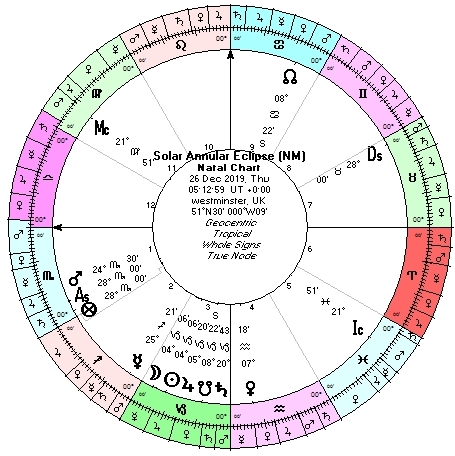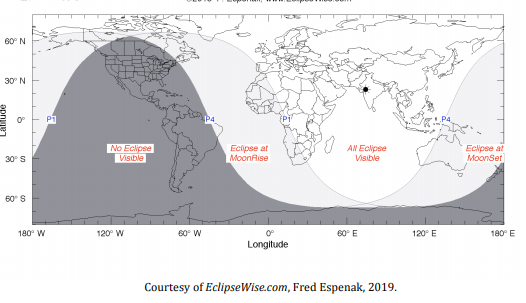-
The following article was published in the APAI Winter Newsletter 2019 where I briefly explored the possible impact of the eclipses in December and January 2020. Traditionally Eclipses were considered potent if they were visible. Otherwise, they are seen as a supercharged New or Full Moon.
The December Eclipse occurs on the 26th December 2019, but is not visible in the UK or Europe.

The information that follows is taken from http://www.eclipsewise.com/oh/ec2019.html

The central track of theannular eclipse crosses the Saudi Arabian Peninsula, southern India, Sumatra, Borneo, Philippines and Guam. A partial eclipse is visible from a much larger region covering much of Asia, northeast Africa, Oceana and western Australia.
The central path begins in Saudi Arabia about 220 kilometers northeast of Riyadh at 03:43 UT1. The path width is 164 kilometers and the duration of annularity is 2 minutes 59 seconds. Although Bahrain lies just outside the path, the southern half of Qatar is within the path of annularity. Continuing to the southeast, the path crosses the southern United Arab Emirates and northern Oman before entering the Arabian Sea.
The antumbral shadow reaches the southwest coast of the Indian subcontinent at 03:56 UT1. On the central line near Kannar, the duration of annularity is 3 minutes 12 seconds, the Sun’s altitude is 32°, and the path width is 129 kilometers.
Traveling with a ground speed of about 1.1 kilometers/second, it takes the antumbral shadow 8 minutes to cross India reaching its southeast coast at 04:04 UT1. It sweeps over northern Sri Lanka before heading into the Bay of Bengal.
Malaysia’s Palau and Sumatra are the next landfall as well as the city-nation of Singapore. Greatest eclipse occurs in eastern Sumatra at 05:17:48 UT1, with an annular duration of 3 minutes 39 seconds. Racing across the South China Sea, the central track crosses Borneo and the Celebes Sea as it curves to the northeast and passes south of the Philippines archipelago.
As it heads across the western Pacific, the antumbral shadow encounters Guam at 6:56 UT1. The Sun’s altitude is 13° during the 3 minute 10 second annular phase. Three minutes later, the umbra reaches Earth’s terminator and rises back into space.
During the course of its 3.3-hour trajectory, the antumbra’s track is approximately 12,900 kilometers long and covers 0.34% of Earth’s surface area.
This is the 46th eclipse of Saros 132 (Espenak and Meeus, 2006). The series began on 1208 Aug 13 with a string of 20 partial eclipses. The series continued with 33 consecutive annular eclipses from 1569 Mar 17 to 2146 Mar 12. Saros 132 then changes character with 2 hybrid eclipses from 2164 Mar 23 to 2182 Apr 03. The first of 7 total eclipses occurs on 2200 Apr 14. The series reverts back to partial with the eclipse of 2326 Jun 30. It will continue producing partial eclipses until the series ends on 2470 Sep 25. In all, Saros 132 produces 71 solar eclipses in the sequence of 20 partial, 33 annular, 2 hybrid, 7 total and 9 partial eclipses.
For additional details on this event, see the EclipseWise Prime Page on the Annular Solar Eclipse of 2019 December 26.This would suggest we can expect news of perhaps further earthquakes, or Volcanic eruptions in these areas.
Although the Solar Eclipse is not visible in Europe, the Lunar eclipse on the 10th January 2020 is.


This eclipse falls at 20 Cancer/Capricorn, and not only involves the Lights, but also Mercury, Jupiter and Saturn. The degree of 20 Capricorn is within 1 degree of the 1801 Moon which is located in the 10th house of that chart.
According to Ramesey in Astrologia Munda, eclipses falling in Earth signs indicates scarcity of crops. Under the section on the Lord or Dispositor, he gives: So that if Saturn is only chief Lord or ruler, he shall be generally the occasion of destruction and mischief caused by cold. And particularly when his influence relates unto men he causes long and tedious infirmities, sickness and obnoxious diseases occasioned from humours, phlegm and defluxions, quartain fevers, banishment, want, tribulation, anxiety, fears, sadness and death; and these chiefly to those that are stricken in years.
Here we have the Regal sign of Leo rising. The Ascendant is closely conjunct the 1801 Saturn in the 11th house. The 11th relates to the Exchequer. In the 1801 chart, the Moon falls in the 10th sign which has relationship with “Kings”, Rulers, Heads of Government and those who have rulership over us. This would seem to indicate there will be news regarding the Royal Family, Trading and partnership agreements. With the recent tumultuous events (that aren’t over yet), it is worth noting the other conjunctions of the planets with the 1801 chart:


The MC degree of the Eclipse chart conjoins the dysfunctional Mars of the 1801 chart, suggesting problems connected with finances of the common people and partners, that will involve a change of status. Something will be cut!
Perhaps this indicates issues over the divorce bill from the EU?Transiting Jupiter is conjoined the IC and conjunct the Sun – however, this will be applicable for all entities with a birthday on the 1st January.
The “stand outs” are the degree of the IC of the 1801 chart being activated, along with the Ascendant degree of the 1801 chart by Jupiter.
Jupiter rules the 3rd and 6th houses. These houses are traditionally associated with education, journeys, communication and health, public servants and Unions. We know there have been pledges to increase the financial contribution from the Government to help the NHS and schools by increasing staff levels and building more facilities. This won’t happen overnight, but perhaps the seeds will be sown for massive investment indicated by Jupiter.
It is also probable we will have some news from the Royal family as the degree of the Eclipse picks up Her Majesty’s Rising/Setting degree.
To make any detailed predictions concerning the effects of the Eclipses, one needs to examine many charts, so I will leave this brief synopsis here.
Contact me for more information
Sharon Knight Astrologer of the Year 2016.
Sharon Knight Astrologer of the Year 2016 - Copyright


